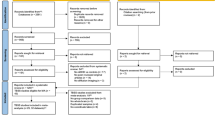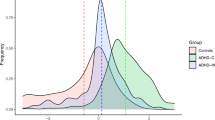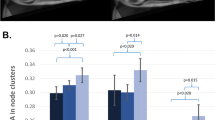Abstract
Studies of brain alterations in children with attention-deficit/hyperactivity disorder (ADHD) have shown heterogeneous results. The aims of the current study were to investigate white matter microstructure in children using both categorical and dimensional definitions of ADHD and to determine the functional consequences of observed alterations. In a large single-site sample of children (aged 8–15 years) with ADHD (n=83) and healthy controls (n=122), we used tract-based spatial statistics on diffusion tensor imaging data to investigate whole-skeleton differences of fractional anisotropy (FA), mean, axial, and radial diffusivity (MD, AD, RD), and mode of anisotropy related to ADHD status (categorical) and symptom severity (dimensional). For categorical differences observed, we analyzed their association with cognitive functioning in working memory and inhibition. Compared with healthy controls, children with ADHD showed decreased FA and increased RD in widespread, overlapping brain regions, mainly in corpus callosum (CC) and major tracts in the left hemisphere. Decreased FA was associated with inhibition performance in the participants with ADHD. Using dimensional definitions, greater hyperactivity/impulsivity symptom severity was associated with higher FA also in widespread regions, mainly in CC and major tracts in the right hemisphere. Our study showed white matter alterations to be related to ADHD status and symptom severity in patients. The coexistence of decreased FA and increased RD in the absence of alterations in MD or AD might indicate altered myelination as a pathophysiological factor in ADHD.
Similar content being viewed by others
Log in or create a free account to read this content
Gain free access to this article, as well as selected content from this journal and more on nature.com
or
References
Alexander AL, Hurley SA, Samsonov AA, Adluru N, Hosseinbor AP, Mossahebi P et al (2011). Characterization of cerebral white matter properties using quantitative magnetic resonance imaging stains. Brain Connect 1: 423–446.
Bedard AC, Newcorn JH, Clerkin SM, Krone B, Fan J, Halperin JM et al (2014). Reduced prefrontal efficiency for visuospatial working memory in attention-deficit/hyperactivity disorder. J Am Acad Child Adolesc Psychiatry 53: 1020–1030 e1026.
Bode MK, Lindholm P, Kiviniemi V, Moilanen I, Ebeling H, Veijola J et al (2015). DTI abnormalities in adults with past history of attention deficit hyperactivity disorder: a tract-based spatial statistics study. Acta Radiologica 56: 990–996.
Casey BJ, Epstein JN, Buhle J, Liston C, Davidson MC, Tonev ST et al (2007). Frontostriatal connectivity and its role in cognitive control in parent-child dyads with ADHD. Am J Psychiatry 164: 1729–1736.
Chabernaud C, Mennes M, Kelly C, Nooner K, Di Martino A, Castellanos FX et al (2012). Dimensional brain-behavior relationships in children with attention-deficit/hyperactivity disorder. Biol Psychiatry 71: 434–442.
Chen L, Hu X, Ouyang L, He N, Liao Y, Liu Q et al (2016). A systematic review and meta-analysis of tract-based spatial statistics studies regarding attention-deficit/hyperactivity disorder. Neurosci Biobehav Rev 68: 838–847.
Chen W, Zhou K, Sham P, Franke B, Kuntsi J, Campbell D et al (2008). DSM-IV combined type ADHD shows familial association with sibling trait scores: a sampling strategy for QTL linkage. Am J Med Genet B Neuropsychiatr Genet 147B: 1450–1460.
de Luis-Garcia R, Cabus-Pinol G, Imaz-Roncero C, Argibay-Quinones D, Barrio-Arranz G, Aja-Fernandez S et al (2015). Attention deficit/hyperactivity disorder and medication with stimulants in young children: a DTI study. Prog Neuropsychopharmacol Biol Psychiatry 57: 176–184.
Dewey D, Crawford SG, Kaplan BJ (2003). Clinical importance of parent ratings of everyday cognitive abilities in children with learning and attention problems. J Learn Disabil 36: 87–95.
DuPaul GJ PT, Anastopoulos AD, Reid R (1998) ADHD Rating Scale-IV: Checklists, Norms, and Clinical Interpretations. Guilford: New York, NY, USA.
Elton A, Alcauter S, Gao W (2014). Network connectivity abnormality profile supports a categorical-dimensional hybrid model of ADHD. Hum Brain Mapp 35: 4531–4543.
Ercan ES, Suren S, Bacanli A, Yazici KU, Calli C, Ardic UA et al (2016). Altered structural connectivity is related to attention deficit/hyperactivity subtypes: A DTI study. Psychiatry Res e-pub ahead of print 14 April 2016.
Ezpeleta L, Granero R (2015). Executive functions in preschoolers with ADHD, ODD, and comorbid ADHD-ODD: evidence from ecological and performance-based measures. J Neuropsychol 9: 258–270.
Feldman HM, Yeatman JD, Lee ES, Barde LHF, Gaman-Bean S (2010). Diffusion tensor imaging: a review for pediatric researchers and clinicians. J Dev Behav Pediatr 31: 346–356.
Gioia GA, Isquith PK, Guy SC, Kenworthy L (2000). Behavior rating inventory of executive function. Child Neuropsychol 6: 235–238.
Gong YX CT (1993) Manual of Chinese revised Wechsler Intelligence Scale for Children. Hunan Atlas Publishing House: Changsha, China.
Hong SB, Zalesky A, Fornito A, Park S, Yang YH, Park MH et al (2014). Connectomic disturbances in attention-deficit/hyperactivity disorder: a whole-brain tractography analysis. Biol Psychiatry 76: 656–663.
Jacobson LA, Peterson DJ, Rosch KS, Crocetti D, Mori S, Mostofsky SH (2015). Sex-Based dissociation of white matter microstructure in children with attention-deficit/hyperactivity disorder. J Am Acad Child Adolesc Psychiatry 54: 938–946.
Kaufman J, Birmaher B, Brent D, Rao U, Flynn C, Moreci P et al (1997). Schedule for affective disorders and schizophrenia for school-age children-present and lifetime version (K-SADS-PL): initial reliability and validity data. J Am Acad Child Adolesc Psychiatry 36: 980–988.
Konrad A, Dielentheis TF, El Masri D, Bayerl M, Fehr C, Gesierich T et al (2010). Disturbed structural connectivity is related to inattention and impulsivity in adult attention deficit hyperactivity disorder. Eur J Neurosci 31: 912–919.
Lubke GH, Hudziak JJ, Derks EM, van Bijsterveldt TCEM, Boomsma DI (2009). Maternal ratings of attention problems in ADHD: evidence for the existence of a continuum. J Am Acad Child Adolesc Psychiatry 48: 1085–1093.
Mori S, Oishi K, Jiang H, Jiang L, Li X, Akhter K et al (2008). Stereotaxic white matter atlas based on diffusion tensor imaging in an ICBM template. NeuroImage 40: 570–582.
Oldfield RC (1971). The assessment and analysis of handedness: the Edinburgh inventory. Neuropsychologia 9: 97–113.
Onnink AM, Zwiers MP, Hoogman M, Mostert JC, Dammers J, Kan CC et al (2015). Deviant white matter structure in adults with attention-deficit/hyperactivity disorder points to aberrant myelination and affects neuropsychological performance. Prog Neuropsychopharmacol Biol Psychiatry 63: 14–22.
Pavuluri MN, Yang S, Kamineni K, Passarotti AM, Srinivasan G, Harral EM et al (2009). Diffusion tensor imaging study of white matter fiber tracts in pediatric bipolar disorder and attention-deficit/hyperactivity disorder. Biol Psychiatry 65: 586–593.
Poelmans G, Pauls DL, Buitelaar JK, Franke B (2011). Integrated genome-wide association study findings: identification of a neurodevelopmental network for attention deficit hyperactivity disorder. Am J Psychiatry 168: 365–377.
Roalf DR, Quarmley M, Elliott MA, Satterthwaite TD, Vandekar SN, Ruparel K et al (2016). The impact of quality assurance assessment on diffusion tensor imaging outcomes in a large-scale population-based cohort. NeuroImage 125: 903–919.
Shang CY, Wu YH, Gau SS, Tseng WY (2013). Disturbed microstructural integrity of the frontostriatal fiber pathways and executive dysfunction in children with attention deficit hyperactivity disorder. Psychol Med 43: 1093–1107.
Silk TJ, Vilgis V, Adamson C, Chen J, Smit L, Vance A et al (2015). Abnormal asymmetry in frontostriatal white matter in children with attention deficit hyperactivity disorder. Brain Imaging Behav e-pub ahead of print 2 November 2015.
Simon V, Czobor P, Balint S, Meszaros A, Bitter I (2009). Prevalence and correlates of adult attention-deficit hyperactivity disorder: meta-analysis. Br J Psychiatry 194: 204–211.
Skogan AH, Zeiner P, Egeland J, Urnes AG, Reichborn-Kjennerud T, Aase H (2015). Parent ratings of executive function in young preschool children with symptoms of attention-deficit/-hyperactivity disorder. Behav Brain Funct 11: 16.
Smith SM, Jenkinson M, Johansen-Berg H, Rueckert D, Nichols TE, Mackay CE et al (2006). Tract-based spatial statistics: voxelwise analysis of multi-subject diffusion data. NeuroImage 31: 1487–1505.
Smith SM, Nichols TE (2009). Threshold-free cluster enhancement: addressing problems of smoothing, threshold dependence and localisation in cluster inference. NeuroImage 44: 83–98.
Tamm L, Barnea-Goraly N, Reiss AL (2012). Diffusion tensor imaging reveals white matter abnormalities in attention-deficit/hyperactivity disorder. Psychiatry Res 202: 150–154.
Thapar A, Cooper M (2015). Attention deficit hyperactivity disorder. Lancet 387: 1240–1250.
Thomas R, Sanders S, Doust J, Beller E, Glasziou P (2015). Prevalence of attention-deficit/hyperactivity disorder: a systematic review and meta-analysis. Pediatrics 135: e994–1001.
van Ewijk H, Heslenfeld DJ, Zwiers MP, Buitelaar JK, Oosterlaan J (2012). Diffusion tensor imaging in attention deficit/hyperactivity disorder: a systematic review and meta-analysis. Neurosci Biobehav Rev 36: 1093–1106.
van Ewijk H, Heslenfeld DJ, Zwiers MP, Faraone SV, Luman M, Hartman CA et al (2014). Different mechanisms of white matter abnormalities in attention-deficit/hyperactivity disorder: a diffusion tensor imaging study. J Am Acad Child Adolesc Psychiatry 53: 790–799 e793.
van Rooij D, Hartman CA, Mennes M, Oosterlaan J, Franke B, Rommelse N et al (2015). Altered neural connectivity during response inhibition in adolescents with attention-deficit/hyperactivity disorder and their unaffected siblings. Neuroimage Clin 7: 325–335.
Walhovd KB, Johansen-Berg H, Karadottir RT (2014). Unraveling the secrets of white matter—bridging the gap between cellular, animal and human imaging studies. Neuroscience 276: 2–13.
Wu YH, Gau SS, Lo YC, Tseng WY (2014). White matter tract integrity of frontostriatal circuit in attention deficit hyperactivity disorder: association with attention performance and symptoms. Hum Brain Mapp 35: 199–212.
Yang L, Neale BM, Liu L, Lee SH, Wray NR, Ji N et al (2013). Polygenic transmission and complex neuro developmental network for attention deficit hyperactivity disorder: genome-wide association study of both common and rare variants. Am J Med Genet B Neuropsychiatr Genet 162B: 419–430.
Yoncheva YN, Somandepalli K, Reiss PT, Kelly C, Di Martino A, Lazar M et al (2016). Mode of anisotropy reveals global diffusion alterations in attention-deficit/hyperactivity disorder. J Am Acad Child Adolesc Psychiatry 55: 137–145.
Zwiers MP (2010). Patching cardiac and head motion artefacts in diffusion-weighted images. NeuroImage 53: 565–575.
Acknowledgements
We disclosed receipt of the following financial support for the research, authorship, and/or publication of this article: This work was supported by the National Basic Research Program of China (973 program 2014CB846104, to Yu-Feng Wang), the National Natural Science Foundation of China (81471382, to Qing-Jiu Cao), and the China Scholarship Council (CSC201406010251, to Zhao-Min Wu). The study was also supported by a Vici grant from the Netherlands Organization for Scientific Research (NWO) (grant 016-130-669 to Barbara Franke), and by a grant from the European Community’s Seventh Framework Programme (FP7/2007–2013) under grant agreement n° (TACTICS).
Author information
Authors and Affiliations
Corresponding author
Additional information
Supplementary Information accompanies the paper on the Neuropsychopharmacology website
Supplementary information
PowerPoint slides
Rights and permissions
About this article
Cite this article
Wu, ZM., Bralten, J., Cao, QJ. et al. White Matter Microstructural Alterations in Children with ADHD: Categorical and Dimensional Perspectives. Neuropsychopharmacol 42, 572–580 (2017). https://doi.org/10.1038/npp.2016.223
Received:
Revised:
Accepted:
Published:
Issue date:
DOI: https://doi.org/10.1038/npp.2016.223
This article is cited by
-
Deep adversarial learning identifies ADHD-specific associations between apoptotic genes and white matter microstructure in frontal-striatum-cerebellum circuit
Translational Psychiatry (2025)
-
Quantification of myelination in children with attention-deficit/hyperactivity disorder: a comparative assessment with synthetic MRI and DTI
European Child & Adolescent Psychiatry (2024)
-
White matter alterations in Attention-Deficit/Hyperactivity Disorder (ADHD): a systematic review of 129 diffusion imaging studies with meta-analysis
Molecular Psychiatry (2023)
-
Association between attention-deficit/hyperactivity disorder symptom severity and white matter integrity moderated by in-scanner head motion
Translational Psychiatry (2022)
-
Sex differences in microstructural alterations in the corpus callosum tracts in drug-naïve children with ADHD
Brain Imaging and Behavior (2022)



